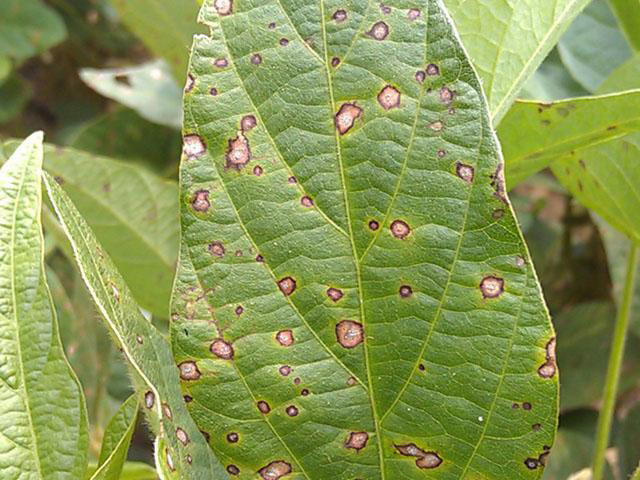
There have been several reports over the last two weeks of heavy frogeye leaf spot pressure in some soybean fields, as well as low to moderate pressure in others.
This disease will continue to increase and infect new foliage as it develops on these late-planted soybeans.
Based on previous research, only once in 14 years of studies did applications at the soybean growth stage R5 contribute to preserved yield. That was in 2018.
At the R5, the leaf at the terminal is fully developed, and the pods at any one of the top four nodes is fully expanded, but the seeds are just beginning to expand.
New territory
For soybeans that have frogeye and have just begun to flower, are at full flower or have just reached the R3 growth stage, these decisions are going to be challenging.
In full disclosure, there’s no data or examples to rely on here. This late planting and late development is all new territory for all of us. But there are some sound principles to rely on.
For soybeans that are in the R3 growth stage, pods are tiny, 3/16 of an inch at one of the four uppermost nodes of the plant.
This growth stage in Ohio typically occurs in mid to late July on May planted soybeans.
Questions to consider
Here are the questions to address for 2019 and in the order of importance.
The value of the crop — are these soybeans grown for seed? If so, err on the side of caution and apply the fungicide and make a second application 14 days later.
Are these soybeans under contract, and will you actually be able to sell them? If the answer is no, then adding more inputs into the crop may not be a sound investment.
Will the soybean finish making grain before harvest? This question will most likely affect soybeans that are just now in full flower. A long fall will impact the return on applying the fungicide.
How susceptible is the variety? For some resistant varieties, the frogeye leaf spots are small and only a few will form on each leaf.
So double check with your seed supplier to look at the ratings. Your seed dealer will want to watch this variety and work with their breeders.
If you spray
If you do decide to spray, leave unsprayed check strips — at least three separate locations in the field — and collect the yield off each of these separately.
The same is true for the fungicides sprayed strips. Collect the data from these as well. The yield maps will be especially important this year.
Secondly, choose the cheapest triazole fungicide that you can find. This is going to be very important for the economic viability of this year’s crop.
Also remember, QoI resistance has been detected in Ohio, and it is not advisable to spray these types of fungicides at these late dates on crops that are further behind in development.
If you don’t spray, and it is a highly susceptible variety, the disease will continue to increase on the plants, but only if periodic rains and heavy dews or fogs continue through the remainder of this crazy field season. Mark this field and this variety.
These are important considerations for 2020 field season as this disease does overwinter in Ohio.
Replanting in the same field with the same variety or one that is susceptible to this disease is a recipe for further yield loss in the future.









